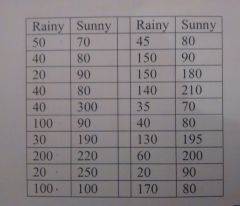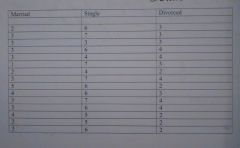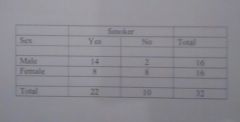![]()
![]()
![]()
Use LEFT and RIGHT arrow keys to navigate between flashcards;
Use UP and DOWN arrow keys to flip the card;
H to show hint;
A reads text to speech;
27 Cards in this Set
- Front
- Back

|
T-Test |
|

|
One-way ANOVA |
|

|
Two-way ANOVA (3x2) |
|

|
Two-way ANOVA (2x2) |
|

|
Correlation |
|

|
Chi-squared |
|

|
Regression |
|
|
Measurement reactivity |
participants behave differently because they are being observed. Eg, Hawthorne power plant study |
|
|
Nominal |
"name” scales with property of identity; to categorize participants Count frequency of participants in each category Qualitative, not quantitative Eg, gender, place of birth, brand name |
|
|
Ordinal |
measures a variable in order of magnitude, gives identity and magnitude Called “Ordered data” Eg, academic grades, socioeconomic status |
|
|
Interval |
(ie, Likert) identity & magnitude w/equal intervals between consecutive values Most common way to measure in psych Called “Score data” Eg, IQ scores, neuroticism scores No true 0 |
|
|
Ratio |
have a true 0 point PLUS: identity, magnitude, & equal intervals Called “Score data” too. Eg, weight, distance, time |
|
|
PROS of within design |
No group differences due to sampling error No confounding due to selection More sensitive to effects of x (eliminates variance of individual differences) Need less participants |
|
|
CONS of within design |
Conditions are correlated, since participants are exposed to both. Cannot be used for sex differences. Sequence effect. |
|
|
Sequence effect |
Exposure to earlier condition can affect performance on later condition e.g.- practice effect, carryover effect |
|
|
Practice effect |
influences on performance that arises from practicing a task; can be positive or negative |
|
|
Carryover effect |
possibility that effects from previous conditions may still be present/affect the new/later condition (eg, testing two drugs) |
|
|
Counterbalancing |
(varying order of conditions) & allowing sufficient time between conditions can help control for sequencing effect. |
|
|
BEST sampling |
Good sample needed to generalize findings. Need a representative sample - that reflects population characteristics. Random - drawing participants so that every member of the pop has equal chance selection (selections are independent of one another) |
|
|
Alternative sampling |
1. nonprobability sampling/convenience sampling (eg, first 50 people) 2. make a non-random sample “representative”, to mirror general pop in some ways |
|
|
Reliability |
degree to which an assessment tool produces stable and consistent results. (can be reliable but not valid) |
|
|
Validity |
how well a test measures what it is purported to measure. (cannot have validity without reliability) |
|
|
[F(1,42)=62.05, p<.001, np2=0.596) [F(2,42)=52.79, p<.001, np2=0.715) [F(2,42)=616.70, p<.001, np2=0.443) |
Two-way ANOVA |
|
|
[r(20)=0.589, p=0.006 two-tailed] |
Correlation |
|
|
[x2(1, N=216)=56.08, p,.001 two tailed, Φ=0.510] |
Chi squared |
|
|
(M=6.60, SD=1.50) (M=4.70, SD=1.41) [f(38)=4.15, p,.001 two tailed, d=1.30] |
T-test |
|
|
[t(19)=-8.82, p<0.001] |
Regression |

